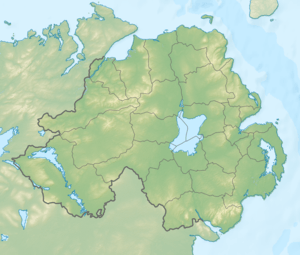Attack on Cloghoge checkpoint
| Attack on the Cloghoge checkpoint | |||||||
|---|---|---|---|---|---|---|---|
| Part of the Troubles and Operation Banner | |||||||
 Entrance to a British Army checkpoint near Newry, late 1980s | |||||||
| |||||||
| Belligerents | |||||||
|
|
| ||||||
| Commanders and leaders | |||||||
| Unknown | Lt. Andrew Rawding[1] | ||||||
| Strength | |||||||
| 2 active service units | At least 24 soldiers | ||||||
| Casualties and losses | |||||||
| None |
1 killed 23 wounded | ||||||
 Location within Northern Ireland | |||||||
The attack on Cloghoge checkpoint was an unconventional bomb attack carried out on 1 May 1992 by the Provisional Irish Republican Army (IRA) against a British Army permanent vehicle checkpoint.[2] The IRA's South Armagh Brigade fitted a van with wheels that allowed it to move along a railway line. A large bomb was placed inside the van, which was then driven along the railway line to the target. The compound, just north of the village of Cloghoge in County Armagh, was wrecked by the explosion.
The attack
During the late hours of 30 April, a group of four Provisional IRA members held a family hostage in Killeen and stole a mechanical excavator. This was to be used to build a makeshift ramp up to the Dublin–Belfast railway line, which drew parallel to the Dublin–Belfast motorway (M1). At the same time, other IRA members stole a Renault Master[1] van in Dundalk, which was then loaded with 2,200 lb (1,000 kg) of home-made explosives. The van was fitted with wheels that could run on the rails. The excavator moved up the ramp and lifted the van onto the railway. The van was then driven some 800 metres north and a mile-long wire attached to a triggering device was added to the bomb. Meanwhile, IRA members in support set up roadblocks on both sides of the border to keep people away.[3] The IRA unit who set up the checkpoint in the Republic wore Garda Síochána uniforms.[2]
At about 2:00 AM, the van was clamped into first gear and directed at the R15 military checkpoint, a permanent vehicle checkpoint on M1 motorway, alongside the railway.[4] A British Army patrol from the 2nd Battalion Royal Regiment of Fusiliers heard what sounded like a train and spotted the van on the rails heading towards the checkpoint, which was alerted immediately. The sentry at R15, Fusilier Andrew Grundy, spotted the incoming threat and alerted the other soldiers in the checkpoint, who rushed to take shelter from the bomb. Grundy tried to disable the device with gunfire, to no avail.[1] Meanwhile, an IRA member, from the high ground south of the position, waited for the van to reach its target. He then radioed the men at the end of the wire to trigger the bomb. At 2:05, the explosive went off, demolishing the checkpoint. The 10-ton sangar was lifted off of its foundation and thrown 12 yards away. Fusilier Grundy was killed almost instantly,[3] while 23 troops were injured.[2] The rest of the soldiers, all inside a reinforced concrete bunker, survived the massive blast.[3]
Aftermath
Fusilier G. A. Colman was awarded a General Officer Commanding commendation for his role in rescuing the body of Fusilier Grundy and the wounded soldiers.[1]
The British Army's official report about this incident stated: "This was a well-planned and well-executed attack indicative of the imaginative, innovative and capable nature of South Armagh PIRA".[5]
The checkpoint was never re-opened. Another smaller PVCP was built a few miles to the west. This new checkpoint cost £7 million, only to be removed in 1998 right after the Good Friday Agreement.[6]
See also
- Chronology of Provisional Irish Republican Army actions (1990-1999)
- Attack on Derryard checkpoint
- Glenanne barracks bombing
- Drummuckavall Ambush
- Proxy bomb
References
- 1 2 3 4 Quote from Regimental history of the Royal Fusiliers: “For England and St George”
- 1 2 3 Operation Banner: An analysis of military operations in Northern Ireland. Prepared under the direction of the Chief of the General Staff, Ministry of Defence July 2006, p. 5-2
- 1 2 3 Harnden, pp. 262–264
- ↑ Dingley, James (2008). Terrorism in Northern Ireland. Routledge, p. 113. ISBN 978-0-415-36733-2
- ↑ Harnden, page 264
- ↑ Harnden, page 265
Further reading
- Dunstan, Simon (2002). For England and St. George: A History of the Royal Regiment of Fusiliers. Helion & Company Limited. ISBN 0-9540067-0-4
- Harnden, Toby (2000). Bandit Country: The IRA & South Armagh. Coronet Books, London. ISBN 0-340-71737-8